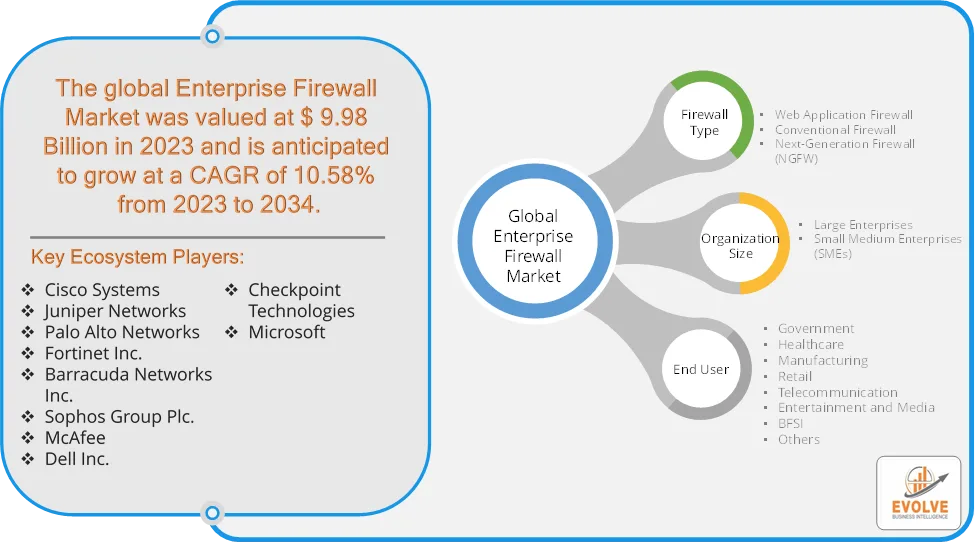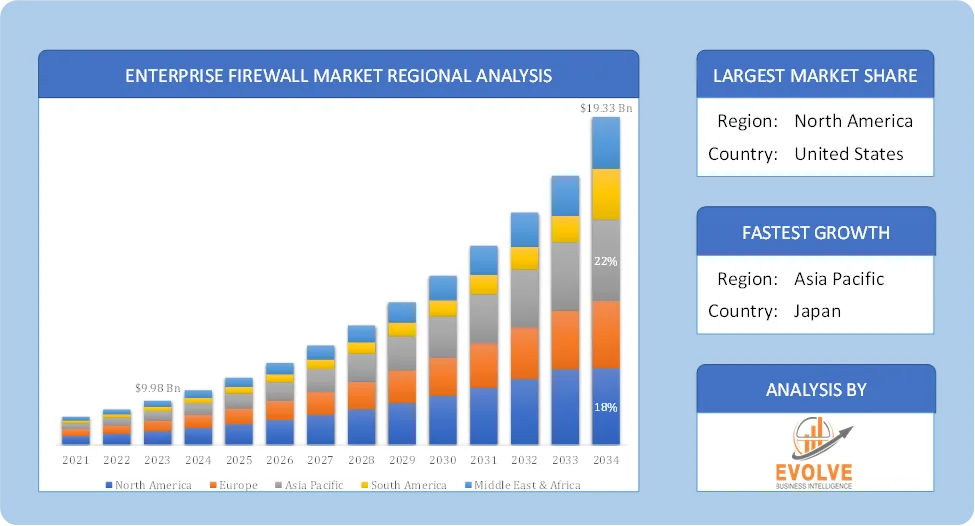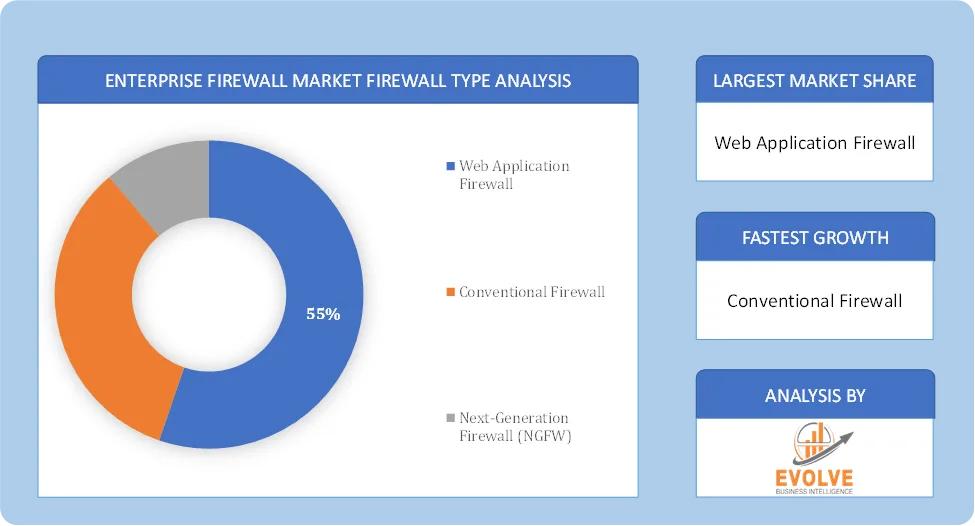Price range: $ 1,390.00 through $ 5,520.00
Enterprise Firewall Market Research Report: Information By Firewall Type (Web Application Firewall, Conventional Firewall, and Next-Generation Firewall (NGFW)), By Organization Size (Large Enterprises, and Small and Medium Enterprises (SMEs)), By End-User (Government, Healthcare, Manufacturing, Retail, Telecommunication, Entertainment and Media, BFSI, and Others), and by Region — Forecast till 2034
Page: 129
Description
Enterprise Firewall Market Overview
The Enterprise Firewall Market size accounted for USD 9.98 Billion in 2023 and is estimated to account for 11.58 Billion in 2024. The Market is expected to reach USD 19.33 Billion by 2034 growing at a compound annual growth rate (CAGR) of 10.58% from 2024 to 2034. The Enterprise Firewall Market focuses on security solutions that protect enterprise networks from cyber threats, unauthorized access, and malware attacks. Enterprise firewalls serve as a critical component of an organization’s cybersecurity infrastructure by filtering incoming and outgoing traffic based on predefined security rules.
The enterprise firewall market is evolving rapidly to address the ever-changing landscape of cybersecurity threats. NGFWs, which offer advanced features like deep packet inspection, intrusion prevention, and application control, are gaining significant traction.
Global Enterprise Firewall Market Synopsis
 Enterprise Firewall Market Dynamics
Enterprise Firewall Market Dynamics
The major factors that have impacted the growth of Enterprise Firewall Market are as follows:
Drivers:
Ø Rising Cybersecurity Threats and Data Breaches
Increasing cyberattacks, such as ransomware, phishing, and DDoS attacks, drive enterprises to adopt advanced firewall solutions. Organizations are investing in robust firewall technologies to protect sensitive business and customer data. The shift to cloud environments requires enterprises to secure their networks with cloud-based firewalls and the rise of hybrid work models and remote access to enterprise systems further increases demand for cloud security and the increasing use of Internet of Things (IoT) devices and Bring Your Own Device (BYOD) policies creates new security challenges.
Restraint:
- High Initial Investment and Maintenance Costs
Advanced next-generation firewalls (NGFWs) and cloud-based firewall solutions require significant upfront investment in hardware, software, and skilled personnel. Small and Medium Enterprises (SMEs) may struggle with high costs, leading to lower adoption rates. Enterprise firewalls need regular updates, rule management, and fine-tuning to ensure effective security and misconfigurations and improper firewall settings can lead to security vulnerabilities or network performance issues.
Opportunity:
⮚ Rising Demand for Next-Generation Firewalls (NGFWs)
AI-powered firewalls with deep learning, behavioral analytics, and automated threat detection offer real-time security. Enterprises are shifting from traditional firewalls to NGFWs that integrate Intrusion Prevention Systems (IPS), Deep Packet Inspection (DPI), and cloud-based security. AI-powered firewalls can automate security monitoring, detect anomalies, and predict potential threats. Self-learning firewalls enhance cybersecurity by continuously adapting to new attack patterns. The expansion of 5G networks and the Internet of Things (IoT) requires advanced firewalls to secure connected devices and edge firewalls and software-defined firewalls (SDFs) are emerging to protect IoT ecosystems.
Enterprise Firewall Market Segment Overview
Based on Firewall Type, the market is segmented based on Web Application Firewall, Conventional Firewall, and Next-Generation Firewall (NGFW). The web application firewall (WAF) segment dominant the market, driven by the increasing need for security solutions that protect HTTP-based applications from cyber threats. WAF solutions, available as hardware appliances, virtual appliances, or cloud-based services, play a crucial role in shielding businesses from malicious web traffic, preventing data breaches, and ensuring compliance with security regulations. As organizations rely more on web applications, the demand for WAFs continues to rise.
By Organization Size
Based on Organization Size, the market segment has been divided into Large Enterprises, and Small and Medium Enterprises (SMEs). Large enterprises dominant the market, primarily due to their extensive IT infrastructure and high-value data assets. These organizations face a heightened risk of cyberattacks, which can lead to severe financial and reputational damage. As a result, they invest heavily in advanced firewall solutions to safeguard sensitive information, ensure regulatory compliance, and maintain business continuity.
By End User
Based on End user, the market segment has been divided into Government, Healthcare, Manufacturing, Retail, Telecommunication, Entertainment and Media, BFSI, and Others. BFSI Segment dominant the market. This segment deals with finances and customers’ data, and to protect the need for critical transactions to some malware, firewalls are necessary for security purposes. The growth in the forecasted years will be attributed to the enhancement in blockchain technologies, as there will be digital currency been used widely in the world. The secure payment gateway has to be significant, and more effective improvements will boost the market’s growth.
Global Enterprise Firewall Market Regional Analysis
Based on region, the global Enterprise Firewall Market has been divided into North America, Europe, Asia-Pacific, the Middle East & Africa, and Latin America. North America is projected to dominate the use of the Enterprise Firewall Market followed by the Asia-Pacific and Europe regions.
 North America Enterprise Firewall Market
North America Enterprise Firewall Market
North America holds a dominant position in the Enterprise Firewall Market. This dominance is attributed to the increasing need for high-speed, real-time security solutions, a surge in ransomware attacks, and stringent government regulations. The U.S. particularly dominates the cloud-based firewall market. The region’s emphasis on deploying advanced network security solutions has been instrumental in maintaining robust defenses against sophisticated cyberattacks. This proactive approach is further supported by stringent governmental regulations aimed at mitigating malware threats across all sectors.
Asia-Pacific Enterprise Firewall Market
The Asia-Pacific region has indeed emerged as the fastest-growing market for the Enterprise Firewall Market industry. Asia Pacific growth is driven by the rapidly expanding IT and telecom sectors, increasing government initiatives promoting digitalization, and the rising popularity of security solutions in countries like China, South Korea, and Japan. There are also significant investments in security infrastructure in this region. The increasing number of small and medium-sized enterprises (SMEs), coupled with regulatory mandates for data protection, has amplified the demand for robust firewall solutions.
Competitive Landscape
The global Enterprise Firewall Market is highly competitive, with numerous players offering a wide range of software solutions. The competitive landscape is characterized by the presence of established companies, as well as emerging startups and niche players. To increase their market position and attract a wide consumer base, the businesses are employing various strategies, such as product launches, and strategic alliances.
Prominent Players:
- Cisco Systems
- Juniper Networks
- Palo Alto Networks
- Fortinet Inc.
- Barracuda Networks Inc.
- Sophos Group Plc.
- McAfee, Dell Inc.
- Checkpoint Technologies
Key Development
In December 2024, Fortinet introduced a unified platform aimed at enhancing web application security and performance, underscoring its commitment to comprehensive cybersecurity solutions.
Scope of the Report
Global Enterprise Firewall Market, by Firewall Type
- Web Application Firewall
- Conventional Firewall
- Next-Generation Firewall (NGFW)),
Global Enterprise Firewall Market, by Organization Size
- Large Enterprises
- Small Medium Enterprises (SMEs)
Global Enterprise Firewall Market, by End User
- Government
- Healthcare
- Manufacturing
- Retail
- Telecommunication
- Entertainment and Media
- BFSI
- Others
Global Enterprise Firewall Market, by Region
- North America
- US
- Canada
- Mexico
- Europe
- UK
- Germany
- France
- Italy
- Spain
- Benelux
- Nordic
- Rest of Europe
- Asia Pacific
- China
- Japan
- South Korea
- Indonesia
- Austalia
- Malaysia
- India
- Rest of Asia Pacific
- South America
- Brazil
- Argentina
- Rest of South America
- Middle East & Africa
- Saudi Arabia
- UAE
- Egypt
- South Africa
- Rest of Middle East & Africa
| Parameters | Indicators |
|---|---|
| Market Size | 2034: USD 19.33 Billion |
| CAGR (2024-2034) | 10.58% |
| Base year | 2022 |
| Forecast Period | 2024-2034 |
| Historical Data | 2021 (2017 to 2020 On Demand) |
| Report Coverage | Revenue Forecast, Competitive Landscape, Growth Factors, and Trends |
| Key Segmentations | Product Type, Application, Distribution Channel |
| Geographies Covered | North America, Europe, Asia-Pacific, South America, Middle East, Africa |
| Key Vendors | Cisco Systems, Juniper Networks, Palo Alto Networks, Fortinet Inc., Barracuda Networks Inc., Sophos Group Plc., McAfee, Dell Inc., Checkpoint Technologies and Microsoft. |
| Key Market Opportunities | · Rising Demand for Next-Generation Firewalls (NGFWs)
· Growing Adoption of AI & Machine Learning in Firewalls |
| Key Market Drivers | · Rising Cybersecurity Threats and Data Breaches
· Growing Adoption of Cloud-Based Security Solutions |
REPORT CONTENT BRIEF:
- High-level analysis of the current and future Enterprise Firewall Market trends and opportunities
- Detailed analysis of current market drivers, restraining factors, and opportunities in the future
- Enterprise Firewall Market historical market size for the year 2021, and forecast from 2023 to 2033
- Enterprise Firewall Market share analysis at each product level
- Competitor analysis with detailed insight into its product segment, Government & Defense strength, and strategies adopted.
- Identifies key strategies adopted including product launches and developments, mergers and acquisitions, joint ventures, collaborations, and partnerships as well as funding taken and investment done, among others.
- To identify and understand the various factors involved in the global Enterprise Firewall Market affected by the pandemic
- To provide a detailed insight into the major companies operating in the market. The profiling will include the Government & Defense health of the company’s past 2-3 years with segmental and regional revenue breakup, product offering, recent developments, SWOT analysis, and key strategies.
[/woodmart_responsive_text_block]
Frequently Asked Questions (FAQ)
What is the growth rate of the global Enterprise Firewall Market?
The global Enterprise Firewall Market is growing at a CAGR of 10.58% over the next 10 years
Which region has the highest growth rate in the market of Enterprise Firewall Market?
Asia Pacific is expected to register the highest CAGR during 2024-2034
Which region has the largest share of the global Enterprise Firewall Market?
North America holds the largest share in 2022
Who are the key players in the global Enterprise Firewall Market?
Cisco Systems, Juniper Networks, Palo Alto Networks, Fortinet Inc., Barracuda Networks Inc., Sophos Group Plc., McAfee, Dell Inc., Checkpoint Technologies and Microsoft. are the major companies operating in the market.
Do you offer Post Sale Support?
Yes, we offer 16 hours of analyst support to solve the queries
Do you sell particular sections of a report?
Yes, we provide regional as well as country-level reports. Other than this we also provide a sectional report. Please get in contact with our sales representatives.
Additional information
| Packages | Single User License, Enterprise License, Data Pack Excel |
|---|



